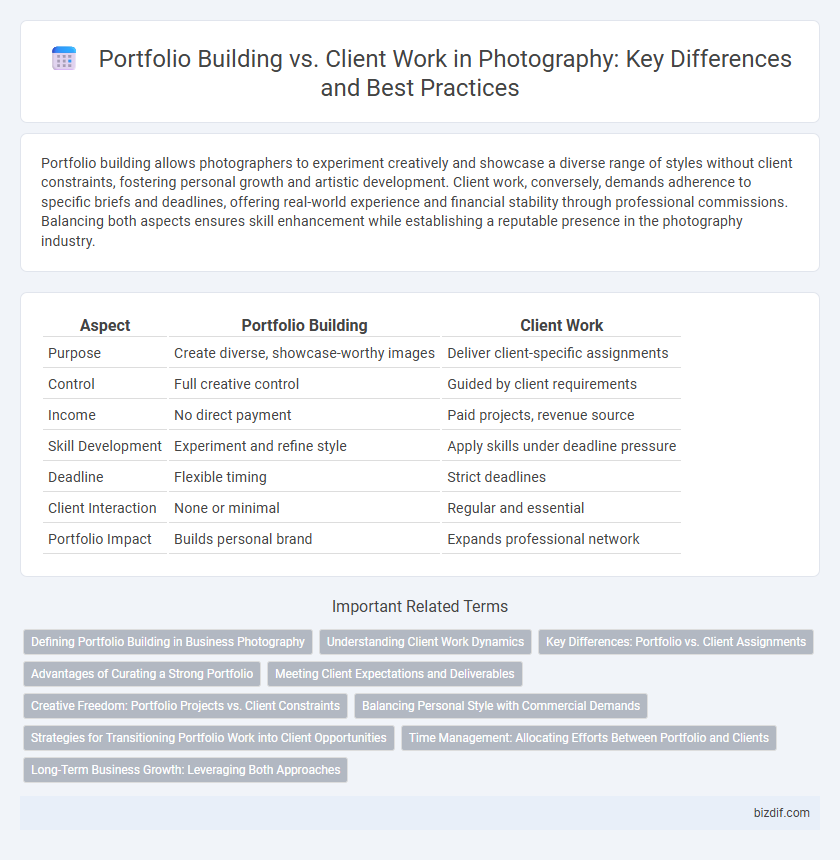Portfolio building allows photographers to experiment creatively and showcase a diverse range of styles without client constraints, fostering personal growth and artistic development. Client work, conversely, demands adherence to specific briefs and deadlines, offering real-world experience and financial stability through professional commissions. Balancing both aspects ensures skill enhancement while establishing a reputable presence in the photography industry.
Table of Comparison
| Aspect | Portfolio Building | Client Work |
|---|---|---|
| Purpose | Create diverse, showcase-worthy images | Deliver client-specific assignments |
| Control | Full creative control | Guided by client requirements |
| Income | No direct payment | Paid projects, revenue source |
| Skill Development | Experiment and refine style | Apply skills under deadline pressure |
| Deadline | Flexible timing | Strict deadlines |
| Client Interaction | None or minimal | Regular and essential |
| Portfolio Impact | Builds personal brand | Expands professional network |
Defining Portfolio Building in Business Photography
Portfolio building in business photography involves creating a curated collection of high-quality images that showcase versatility, style, and technical skills to attract potential clients and establish a professional brand identity. This process emphasizes selecting impactful projects that demonstrate expertise in various business contexts such as corporate headshots, product photography, and event coverage. Unlike client work, which is driven by specific assignments and client needs, portfolio building is a strategic activity aimed at long-term marketing and reputation growth.
Understanding Client Work Dynamics
Understanding client work dynamics in photography involves adapting creative vision to meet specific client needs while adhering to project timelines and budgets. Effective communication and flexibility are crucial for delivering tailored solutions that satisfy client expectations and foster long-term relationships. Balancing artistic integrity with commercial objectives ensures successful client collaborations and continuous professional growth.
Key Differences: Portfolio vs. Client Assignments
Portfolio building emphasizes creative control and diversity of style, enabling photographers to showcase their unique vision and technical skills across various subjects and settings. Client work prioritizes meeting specific requirements, deadlines, and brand guidelines to fulfill the client's objectives, often involving collaboration and revisions. While portfolios serve as a marketing tool to attract future clients, client assignments generate income and professional experience through real-world applications.
Advantages of Curating a Strong Portfolio
Curating a strong photography portfolio showcases diverse skills and unique style, attracting high-quality clients and higher-paying opportunities. A well-crafted portfolio acts as a visual resume that demonstrates technical proficiency, creativity, and consistent results, setting photographers apart in competitive markets. Investing time in portfolio building enhances credibility and helps photographers establish a distinct brand identity, increasing visibility and client trust.
Meeting Client Expectations and Deliverables
Meeting client expectations in photography requires clear communication from the outset about deliverables, timelines, and creative direction. Portfolio building allows photographers to experiment and refine their style, but client work demands consistent quality, adherence to brief specifics, and timely delivery of final edited images. Balancing artistic expression with client requirements ensures satisfaction and fosters professional growth in the competitive photography industry.
Creative Freedom: Portfolio Projects vs. Client Constraints
Portfolio projects offer photographers significant creative freedom to experiment with styles, themes, and techniques, enabling the development of a unique artistic voice. Client work often involves adhering to specific briefs, deadlines, and brand guidelines, which can limit creative expression but enhance professional discipline. Balancing portfolio building and client assignments is essential for growth, allowing photographers to refine technical skills while nurturing originality.
Balancing Personal Style with Commercial Demands
Balancing personal style with commercial demands is crucial when building a photography portfolio alongside client work, as portfolios reflect creative identity while client projects require adaptability. Maintaining a consistent visual signature in portfolio pieces helps attract ideal clients, whereas tailoring images to meet client briefs ensures professional reliability and satisfaction. Strategic curation of portfolio content showcasing both artistic vision and versatility maximizes opportunities in diverse photography markets.
Strategies for Transitioning Portfolio Work into Client Opportunities
Developing a diverse and high-quality photography portfolio is essential for attracting client work and showcasing your unique style and technical skills. Leveraging portfolio pieces on social media platforms and professional websites can increase visibility and demonstrate your expertise to potential clients. Networking with industry professionals and offering limited-time promotions based on portfolio projects can effectively convert creative work into paid assignments.
Time Management: Allocating Efforts Between Portfolio and Clients
Efficient time management is crucial for photographers balancing portfolio building and client work, with a typical allocation recommending 60% towards client projects to ensure steady income and 40% for portfolio development to showcase artistic growth and attract future clients. Prioritizing client deadlines while setting specific hours weekly for portfolio shoots helps maintain consistent creative output without compromising professional commitments. Using project management tools and scheduling software streamlines workflow, optimizing productivity and enhancing overall career progression.
Long-Term Business Growth: Leveraging Both Approaches
Balancing portfolio building and client work is essential for sustained growth in photography businesses. A diverse portfolio showcases versatility and skill, attracting high-value clients while client assignments generate steady revenue and market credibility. Leveraging both enables photographers to expand their brand presence, foster client relationships, and scale their business effectively over time.
Portfolio Building vs Client Work Infographic

 bizdif.com
bizdif.com